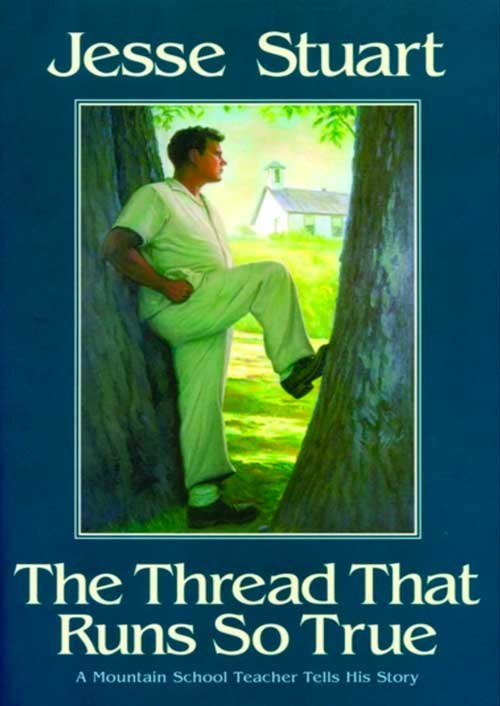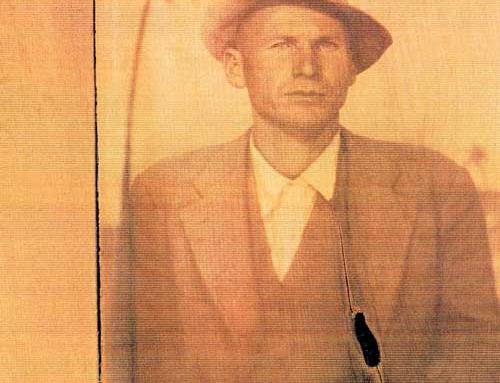In the 1940s and 1950s, books opened my mind to the big world beyond my poor Appalachian home. When I was a little boy, my grandmother, Clara Moore Clark, would walk to town with me so that I could check out books from the Bedford County Public Library. I still remember my astonishment when the librarian said I could check out three books. I always looked through the baseball books and adventure novels carefully before making my selections. When I was a little older, my grandmother, who was my eighth-grade teacher, introduced me and my classmates to Jesse Stuart, and Stuart influenced my decision to become a teacher, just as he did with hundreds of thousands of Americans.
 My grandmother could have retired before the 1957-58 school year, but she chose to teach another year at Shelbyville Junior High School so that I could be in her room in the eighth grade. Although I did not realize it at the time, what I learned from her that year established the pattern for the rest of my life. One of my shining memories of that year was her daily reading.
My grandmother could have retired before the 1957-58 school year, but she chose to teach another year at Shelbyville Junior High School so that I could be in her room in the eighth grade. Although I did not realize it at the time, what I learned from her that year established the pattern for the rest of my life. One of my shining memories of that year was her daily reading.
Every day, after lunch, we were required to put our heads down on our desks (at the time I thought it was so that we could rest) and she would read Jesse Stuart books to us in serial fashion. The one I remember best was “The Thread That Runs So True.” I couldn’t wait for the next day’s installment. Would Jesse whip Guy Hawkins? Would he freeze to death on that mountain? Would his students win academic competitions with much larger schools?
Like my grandmother, teachers all across America found a hero and role model in Jesse Stuart and read “Thread” and his other books at every level of the educational system. “The Thread That Runs So True” became much more than a book about teaching in a one-room school. It was a psalm of praise to the teaching profession and Stuart was “the school teacher of America.”
It was also a passionate appeal to all Kentuckians to heal the open wound that was Kentucky’s system of public education. At the beginning of the twentieth century, rural schools were primitive, at best. Most barns and jails were better built, better equipped, and more comfortable than the one-room schools that dotted the hills and hollows of Kentucky.
Five thousand illiterate public officials presided over 24,900 equally illiterate and often uncaring trustees who oversaw 8,300 schools. The system was horribly ineffective, yet the vast majority of Kentuckians did not care. Living in poverty, they saw education as a luxury, not a necessity. When the century began, 100,000 shivering (or sweltering), barefoot children attended 2,000 schools without seats and blackboards while 4,500 other schools had no globes, maps, or educational aids of any kind. In 1933 the average elementary school teacher made $495 per year, and the state stood next to last in the Union in all categories by which state educational systems were measured. Unlike many who wrote reports on the state’s impoverished educational system, Stuart knew the one-room schools on a first-hand basis.
Stuart published “The Thread That Runs So True” 76 years ago to promote an improved educational system that emphasized both literacy and character education. He felt that America’s survival depended on these changes. That was true then, and it is still true. “The Thread That Runs So True” is as important today as it was half a century ago, because many of the same problems still exist in slightly different forms. Society has invested billions of dollars in public education. The buildings are modern, and the libraries are filled with books and computers, but our system is still failing in many ways.
In “Reading at Risk,” the National Endowment for the Arts reported a decline in reading, particularly among the young. Reading declined five percent between 1982 and 1992 and fourteen percent in the following decade. Less than sixty percent of all Americans read a book—any kind of book—in 2005! Less than fifty percent of adults read for pleasure.
Television is a major factor in this disturbing decline. By 1995, television consumed forty percent of Americans’ free time. Today electronic entertainments and television fill five and a half hours in the daily life of an average American child. Not so many years ago, reading was a reward for young people. Now many children see it as a punishment and recoil angrily when their parents suggest that they turn off the television and read a book. Sadly, we have become a less literate society.
“The Thread That Runs So True” is also a clarion call for character education, and that’s something we need more today than we did in 1949, because character in our society is slowly eroding. There are millions of good folks out there who live decent and responsible lives, but there’s also a small but steadily increasing number of Americans who conduct themselves badly. If you doubt this, observe a local stop light for thirty minutes, stand in a check-out line, encourage an adult to put out the cigarette he or she has thrown down, or ask a teenager to stop skateboarding on your property. What you will find are people with no sense of public responsibility.
Character education was a persistent theme in Stuart’s books and in his lectures. Over and over he said, “I’d rather have a C student with an A character, than and A student with a C character.” In 1960 he wrote: “In this second half of the twentieth century, we need to teach that which goes beyond personal security, a full stomach and a fine automobile. We have boasted too loud and too long about our high standards of living. Shouldn’t we aim also, and primarily, for high moral standards, for honesty—in a word, for character? We who are older should set a better example for youth to follow.”
As a nation, let’s accept Stuart’s challenge. Perhaps we can begin by setting a good personal example. We’re all teachers, because we all teach by example. I encourage Americans to read this important book and promote its use. Let’s not sit idle while our society becomes progressively worse. Reading this book is a small step in the right direction, for “The Thread That Runs So True”—a book that promotes literacy, character education, and public responsibility—is a book for our time and for all time.
“The Thread That Runs So True” is available in the Jesse Stuart Foundation Bookstore at 4440 13th Street in Ashland.
By James M. Gifford
JSF CEO & Senior Editor
In the 1940s and 1950s, books opened my mind to the big world beyond my poor Appalachian home. When I was a little boy, my grandmother, Clara Moore Clark, would walk to town with me so that I could check out books from the Bedford County Public Library. I still remember my astonishment when the librarian said I could check out three books. I always looked through the baseball books and adventure novels carefully before making my selections. When I was a little older, my grandmother, who was my eighth-grade teacher, introduced me and my classmates to Jesse Stuart, and Stuart influenced my decision to become a teacher, just as he did with hundreds of thousands of Americans.

My grandmother could have retired before the 1957-58 school year, but she chose to teach another year at Shelbyville Junior High School so that I could be in her room in the eighth grade. Although I did not realize it at the time, what I learned from her that year established the pattern for the rest of my life. One of my shining memories of that year was her daily reading.
Every day, after lunch, we were required to put our heads down on our desks (at the time I thought it was so that we could rest) and she would read Jesse Stuart books to us in serial fashion. The one I remember best was “The Thread That Runs So True.” I couldn’t wait for the next day’s installment. Would Jesse whip Guy Hawkins? Would he freeze to death on that mountain? Would his students win academic competitions with much larger schools?
Like my grandmother, teachers all across America found a hero and role model in Jesse Stuart and read “Thread” and his other books at every level of the educational system. “The Thread That Runs So True” became much more than a book about teaching in a one-room school. It was a psalm of praise to the teaching profession and Stuart was “the school teacher of America.”
It was also a passionate appeal to all Kentuckians to heal the open wound that was Kentucky’s system of public education. At the beginning of the twentieth century, rural schools were primitive, at best. Most barns and jails were better built, better equipped, and more comfortable than the one-room schools that dotted the hills and hollows of Kentucky.
Five thousand illiterate public officials presided over 24,900 equally illiterate and often uncaring trustees who oversaw 8,300 schools. The system was horribly ineffective, yet the vast majority of Kentuckians did not care. Living in poverty, they saw education as a luxury, not a necessity. When the century began, 100,000 shivering (or sweltering), barefoot children attended 2,000 schools without seats and blackboards while 4,500 other schools had no globes, maps, or educational aids of any kind. In 1933 the average elementary school teacher made $495 per year, and the state stood next to last in the Union in all categories by which state educational systems were measured. Unlike many who wrote reports on the state’s impoverished educational system, Stuart knew the one-room schools on a first-hand basis.
Stuart published “The Thread That Runs So True” 76 years ago to promote an improved educational system that emphasized both literacy and character education. He felt that America’s survival depended on these changes. That was true then, and it is still true. “The Thread That Runs So True” is as important today as it was half a century ago, because many of the same problems still exist in slightly different forms. Society has invested billions of dollars in public education. The buildings are modern, and the libraries are filled with books and computers, but our system is still failing in many ways.
In “Reading at Risk,” the National Endowment for the Arts reported a decline in reading, particularly among the young. Reading declined five percent between 1982 and 1992 and fourteen percent in the following decade. Less than sixty percent of all Americans read a book—any kind of book—in 2005! Less than fifty percent of adults read for pleasure.
Television is a major factor in this disturbing decline. By 1995, television consumed forty percent of Americans’ free time. Today electronic entertainments and television fill five and a half hours in the daily life of an average American child. Not so many years ago, reading was a reward for young people. Now many children see it as a punishment and recoil angrily when their parents suggest that they turn off the television and read a book. Sadly, we have become a less literate society.
“The Thread That Runs So True” is also a clarion call for character education, and that’s something we need more today than we did in 1949, because character in our society is slowly eroding. There are millions of good folks out there who live decent and responsible lives, but there’s also a small but steadily increasing number of Americans who conduct themselves badly. If you doubt this, observe a local stop light for thirty minutes, stand in a check-out line, encourage an adult to put out the cigarette he or she has thrown down, or ask a teenager to stop skateboarding on your property. What you will find are people with no sense of public responsibility.
Character education was a persistent theme in Stuart’s books and in his lectures. Over and over he said, “I’d rather have a C student with an A character, than and A student with a C character.” In 1960 he wrote: “In this second half of the twentieth century, we need to teach that which goes beyond personal security, a full stomach and a fine automobile. We have boasted too loud and too long about our high standards of living. Shouldn’t we aim also, and primarily, for high moral standards, for honesty—in a word, for character? We who are older should set a better example for youth to follow.”
As a nation, let’s accept Stuart’s challenge. Perhaps we can begin by setting a good personal example. We’re all teachers, because we all teach by example. I encourage Americans to read this important book and promote its use. Let’s not sit idle while our society becomes progressively worse. Reading this book is a small step in the right direction, for “The Thread That Runs So True”—a book that promotes literacy, character education, and public responsibility—is a book for our time and for all time.
“The Thread That Runs So True” is available in the Jesse Stuart Foundation Bookstore at 4440 13th Street in Ashland.
By James M. Gifford
JSF CEO & Senior Editor




